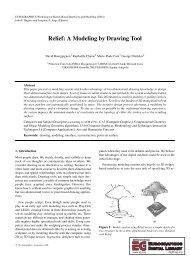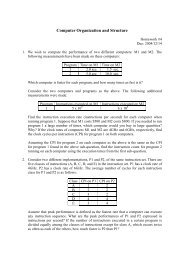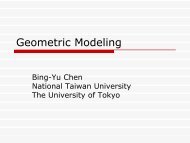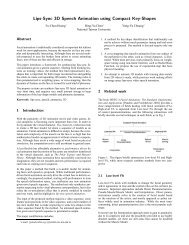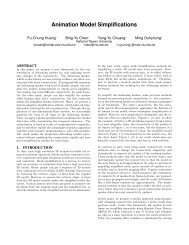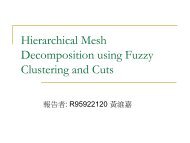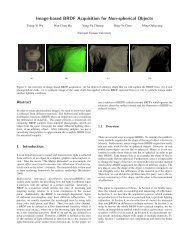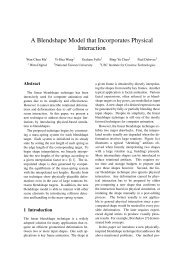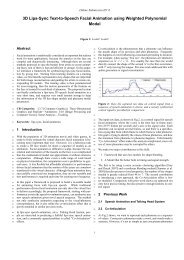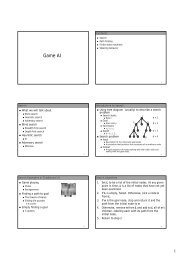Content-Aware Geometry Image Resizing - Computer Graphics ...
Content-Aware Geometry Image Resizing - Computer Graphics ...
Content-Aware Geometry Image Resizing - Computer Graphics ...
You also want an ePaper? Increase the reach of your titles
YUMPU automatically turns print PDFs into web optimized ePapers that Google loves.
In each resizing step, we adaptively decide the image size<br />
of the next step by the energy distribution. Note that I gim is<br />
square and the saliency map ranges in [0,1]. The width and<br />
height in the k-th step can be adaptively decided by:<br />
(a)<br />
Fig. 4. Resize a geometry image from 500 × 500 to 105 × 105 by using<br />
(a) progressive resizing and (b) direct resizing [14].<br />
with other unimportant neighbors. Therefore, the constraints<br />
should be weighted by the corresponding energy value:<br />
(b)<br />
E i,j (x i,j −x i−1,j ) = E i,j ,<br />
E i,j (x i+1,j −x i,j ) = E i,j ,<br />
E i,j (x i,j −x i,j+1 ) = 0.<br />
All the equations form an over-determined constrained<br />
sparse linear system. The optimal positions of the warped<br />
pixels can be obtained by minimizing the error of the above<br />
equations, which is equivalent to finding the least-squares<br />
solution of the sparse linear system:<br />
(3)<br />
Ax ≈ b ⇒ x = (A T A) −1 A T b. (4)<br />
Similarly, the coordinate variables y i,j of pixels (i,j) can<br />
also be obtained from the least-square solution of following<br />
equations:<br />
E i,j (y i,j −y i,j−1 ) = E i,j ,<br />
E i,j (y i,j+1 −y i,j ) = E i,j ,<br />
E i,j (y i,j −y i+1,j ) = 0,<br />
y i,1 = 1,<br />
y i,H = H target .<br />
There are two considerations for applying this warpingbased<br />
method to geometry image resizing. Firstly, we take<br />
a progressive strategy to gradually resize the geometry image<br />
to the target size instead of direct resizing. Progressive<br />
resizing avoids a mass of pixels of low energy to be overdecimated.<br />
Besides, progressive resizing also alleviates the<br />
self-intersection phenomenon produced by [14], which means<br />
the warped pixels are not guaranteed to be positioned in the<br />
same order horizontally and vertically as in the original image.<br />
Since geometry images implicitly encode the connectivity of<br />
3D vertices, this phenomenon results in noticeable artifacts,<br />
such as the kinks of triangular faces as shown in Fig. 4(b).<br />
Secondly, we perform bi-cubic interpolation to reconstruct<br />
appropriate pixel values after warping. In [14], the pixels<br />
mapped to the same position are averaged to obtain the<br />
new pixel value. Empirically, we found this blending strategy<br />
causes the 3D model to shrink, which becomes serious in our<br />
progressive resizing scheme.<br />
(5)<br />
√<br />
W k = H k = max( |{(i,j)|E k−1 (i,j) > λ}|,W target ),<br />
(6)<br />
where the E k−1 is the saliency map obtained from the intermediate<br />
images of the (k−1)-th step and λ is a thresholding<br />
parameter controlling the step size, which is 0.1 in our default<br />
setting. Briefly speaking, Equation (6) counts the number of<br />
pixels with energy higher than λ to decide the dimensions of<br />
resized images. To summarize, the main steps of the proposed<br />
simplification algorithm are given as below:<br />
1) Compute the gradient energy map. (Section II-A)<br />
2) Determine the target image size (W i , H i ). (Eq. 6)<br />
3) Warp I gim and I nmp to the size of (W i , H i ).<br />
4) If W i = W target and H i = H target , stop. Else go to<br />
Step 1.<br />
III.<br />
EXPERIMENTAL RESULTS<br />
In this section, we evaluate the performance of various<br />
image resizing techniques and compare the results with the<br />
proposed method. For validation, we have adopted the METRO<br />
geometric comparison tool [2] to evaluate the deviation of 3D<br />
meshes corresponding to the original and resized geometry<br />
images. The energy maps of different methods [1], [14] and<br />
the proposed method are computed by Equation (1).<br />
A. Evaluation of Various <strong>Image</strong> <strong>Resizing</strong> Methods<br />
We applied the proposed image resizing method to obtained<br />
simplified 3D models of various resolutions, as shown in<br />
Fig. 5 and . It is interesting to note that in [5] Gu et<br />
al. applied JPEG encoding to compress geometry images,<br />
which is essentially different from resizing geometry images.<br />
Compression on geometry images does not alter the complexity<br />
of the corresponding 3D models, but inevitably introduces<br />
loss in accuracy of the mesh vertices. In Fig. 5, the number of<br />
triangles of the original 3D meshes (524288) were reduced to<br />
roughly one half of the original size (278258) without causing<br />
any noticeable visual differences. As discussed in Section II,<br />
an appropriate method which best reconstructs the pixel values<br />
is desirable when performing image resizing. We use three<br />
commonly used data interpolation methods (say, bi-cubic, bilinear<br />
and nearest-neighbor interpolation) to generate multiresolution<br />
3D models of BUNNY and evaluate the deviations<br />
with the original model by using METRO. As shown in Fig. 6,<br />
bi-cubic interpolation produces best results in terms of least<br />
errors measured on the models of lower resolutions. Consistent<br />
results were obtained by resizing other 3D models and thus<br />
we adopt bi-cubic interpolation in the rest experiments when<br />
needed.<br />
For comparison, we applied different image resizing methods,<br />
include regular down-sampling (RDS), seam carving<br />
(SC) and the technique propose in [14] (VR), to generate



